As the most famous furniture designer of the 18th century and possibly ever since, Thomas Chippendale produced numerous designs reflecting the fashionable styles of the period. From grand rococo frills to strong neoclassical statements, it was Chippendale’s chairs that were of particular prominence, with their designs still being replicated today and originals being highly sought after in the antique furniture market.
 Above: a side chair based on a design by Thomas Chippendale with a typical ribband back feature, 1755-60
Above: a side chair based on a design by Thomas Chippendale with a typical ribband back feature, 1755-60
Chippendale furniture – especially if dated to the 18th century – can reach tens of thousands at auction depending on quality and desirability. In this article, we will cover the ways in which you can identify Chippendale design styles, as well as their history and the ways in which our professional furniture experts can restore these valuable pieces with traditional techniques.
 Above: two armchairs made after the ‘French chair’ style in the third edition of The Gentleman and Cabinet-Maker’s Director, dated 1765
Above: two armchairs made after the ‘French chair’ style in the third edition of The Gentleman and Cabinet-Maker’s Director, dated 1765
Who is Thomas Chippendale?
Thomas Chippendale was a furniture maker and designer who lived in London during the mid to late 18th century. Chippendale is well known for his collection of designs which were first published in 1754 in his own trade catalogue entitled The Gentleman and Cabinet Maker’s Director.
 Above: the cover page and plates from The Gentleman and Cabinet Maker’s Director by Thomas Chippendale
Above: the cover page and plates from The Gentleman and Cabinet Maker’s Director by Thomas Chippendale
The Cabinet Maker’s Director publication not only helped to promote his own styles but was the first catalogue of its kind and influenced the beginnings of a mass market in the furniture trade. Chippendale was one of the first global names in furniture manufacturing, with his work being replicated across Britain, Europe and America copying various designs – meaning you will not only find Chippendale furniture from British craftsmen of this period.
 Above: a montage of designs found in Thomas Chippendale’s Cabinet Makers Directory
Above: a montage of designs found in Thomas Chippendale’s Cabinet Makers Directory
As well as creating designs for traditional wooden furniture, Thomas Chippendale was also an interior designer who could advise his clients on a full scheme for a room, including the soft furnishings, colours and layout. This made his business unique and very much like the modern interior designers today, catering for all aspects of a room with items and upholstery sourced from trusted suppliers. In some cases, Chippendale designed rooms for an entire house or stately home, with his aristocratic clients relying on his taste in fashion from Chinoiserie and rococo to neoclassical aesthetics in the latter half of the century.
 Above: drawings for Chippendale’s Gentleman and Cabinet Maker’s Director published in the third edition of 1762
Above: drawings for Chippendale’s Gentleman and Cabinet Maker’s Director published in the third edition of 1762
What makes Chippendale furniture so valuable?
Chippendale furniture is valuable due to the connection it has with its famous designer, Thomas Chippendale was at the forefront of mass furniture design and so furniture which is linked closely to him has significance both culturally and historically. This is very desirable to furniture collectors who prize Chippendale’s design catalogue and influences.
 Above: a line of Chippendale chairs at Harewood House in West Yorkshire
Above: a line of Chippendale chairs at Harewood House in West Yorkshire
Due to the predominance of Chippendale designs in the 18th century and continued reproductions in the 19th century, they form part of what we see as classic furniture. This traditional quality is much admired by those who enjoy a long-established style in their home, as well as collectors who admire the finest versions of Chippendale’s most recognisable work.
Many furniture dealers and auction houses look for select criteria when pricing Chippendale furniture, this includes:
- Age – furniture age can be estimated based on aspects such as veneer thickness (because a thinner veneer was not possible until the machinery processes of the industrial era), as well as the type of wood, techniques used and the decorative fashions that were prevalent in each decade.
- Style – is this related to a popular or rare design from Chippendale’s catalogue of work? Both may have value in their own way with buyers looking for a typical style or collectors searching for a rare chair, table or cabinet. Popular designs by Chippendale include English gothic, Louis XV styles, French rococo, and Chinoiserie.
 Above: a selection of Chippendale designs from the mid 18th century including rococo dining chairs (right) and Chinioserie armchairs (left)
Above: a selection of Chippendale designs from the mid 18th century including rococo dining chairs (right) and Chinioserie armchairs (left)
- Materials – the type of timber can create value and the amount which is used, typically a cheaper piece of antique furniture will only have the veneer of expensive wood or even a mock version of exotic timber such as ebony. Good quality antique furniture that can reach a higher price at auction may use solid pieces of walnut, oak, ebony, or mahogany.
- Craftsmanship & quality – the details of the craftsmanship, such as the exact cuts of wood and fine veneer work, as well as carving techniques and decorative details. Evidence of the craftsman’s hand-sawing and age-related shrinkage of the wood leading to fairly uneven joins is usually an indication of historic, handmade furniture dated to the time of Chippendale’s original designs.
 Above: a selection of Chippendale chairs, including an armchair and a fire screen with tapestry upholstery
Above: a selection of Chippendale chairs, including an armchair and a fire screen with tapestry upholstery
How to identify a Chippendale chair
Chippendale furniture can be identified based on the styles found in The Gentleman and Cabinet Maker’s Director. The most typical of these styles is a chair with a finely carved and bow-crested back, possibly with a ribbon-like design, and cabriole legs (that is where the upper part bows outwards and the lower part bows inwards), these often have a claw or scroll shaped foot. Chippendale’s timber of choice was mahogany and his seated furniture was usually created out of a solid piece rather than using veneers.
 Above: a ribband-back chair from the first edition of Chippendale’s Gentleman and Cabinet-Maker’s Director, 1754
Above: a ribband-back chair from the first edition of Chippendale’s Gentleman and Cabinet-Maker’s Director, 1754
The Chippendale chair is the most common piece of furniture you may come across in this genre of antique furniture. Their large quantity in the market is often due to the many sets of Chippendale dining chairs, as they were designed for aristocratic homes these often come in high numbers to fit around a substantially sized table.
 Above: a Chippendale mahogany dining chair with neoclassical features dated to 1772
Above: a Chippendale mahogany dining chair with neoclassical features dated to 1772
These are aspects you may find on a traditional Chippendale chair:
- Ornamental carving with rococo, neoclassical, or gothic revival features, a ribband back appearing as a flowing ribbon and rippled bow is a classic example
- Cabriole legs which bow outwards and then inwards
- Good proportions which seem to have been well considered by the designer
- Ball and claw feet or scrolled feet, or plain square legs on gothic or neoclassical designs
- Upholstery on the seat is common, but the textiles will very rarely be the original
- Latticework and lacquering may be found on Chinese inspired chairs
- Solid mahogany wood was the type preferred by Chippendale for seating
 Above: a selection of Gothic and Louis XV style chair designs from the Chippendale cabinet maker’s catalogue
Above: a selection of Gothic and Louis XV style chair designs from the Chippendale cabinet maker’s catalogue
Chippendale furniture restoration
Our furniture restoration studio offers the traditional repair of antique furniture from all eras, including chairs, dining tables, cabinets and all manner of furniture with a Chippendale design. This includes the sensitive restoration of decorative features and solid wood surfaces, ensuring the safe preservation of these historic items, as well as their ongoing functional use if required.
 Above: an antique chair which was restored in our furniture studio following flood damage
Above: an antique chair which was restored in our furniture studio following flood damage
Broken or loose joins can be rectified by carefully taking the furniture apart and reconstructing it with added strength where needed. Any new parts added will always consider the original material and be as close to this as possible and colour-matched, with some elements being sourced from other antique furniture which has been salvaged. Often our team also find missing brass handles, veneers or inlays which require a historically sensitive replacement, this can be researched and replaced with an appropriate option to allow for the ongoing integrity of the furniture as a valuable antique item.
 Above: a mahogany extender table before and after restoration by our team including a french polish finish
Above: a mahogany extender table before and after restoration by our team including a french polish finish
Water damage is another common issue, whether this is from accidental spills or major flooding incidents it can cause staining and contamination which sinks into the wood grain. Much of the value of Chippendale furniture comes from the traditional visual appeal and good quality appearance of the piece, so it is important that any unsightly issues are professionally repaired. Whilst some staining may remain due to the historic nature of the piece with signs of general wear over time, deep and disturbing stains can often be removed with precise techniques. The surfaces can then be re-stained with historically appropriate shades or a tone to suit your preference, as well as superbly finished with French polishing and waxing treatments.
How can we help?
If you have a Chippendale chair, table, cabinet, or another piece of furniture that is of importance to you, please contact our team for further advice on the restoration, repair and conservation of antique furniture in our specialist studio.
To make contact please email us via [email protected] or call 0207 112 7576
You might also be interested in:

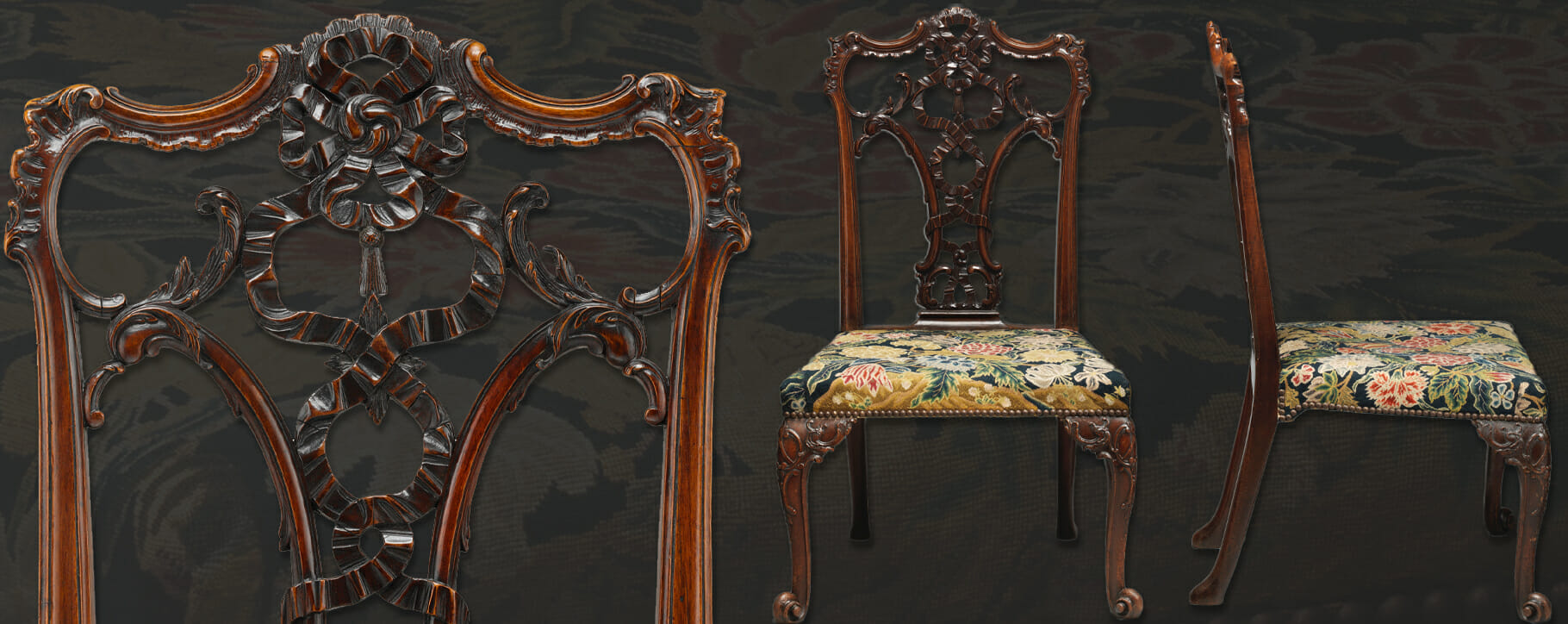 Above: a side chair based on a design by Thomas Chippendale with a typical ribband back feature, 1755-60
Above: a side chair based on a design by Thomas Chippendale with a typical ribband back feature, 1755-60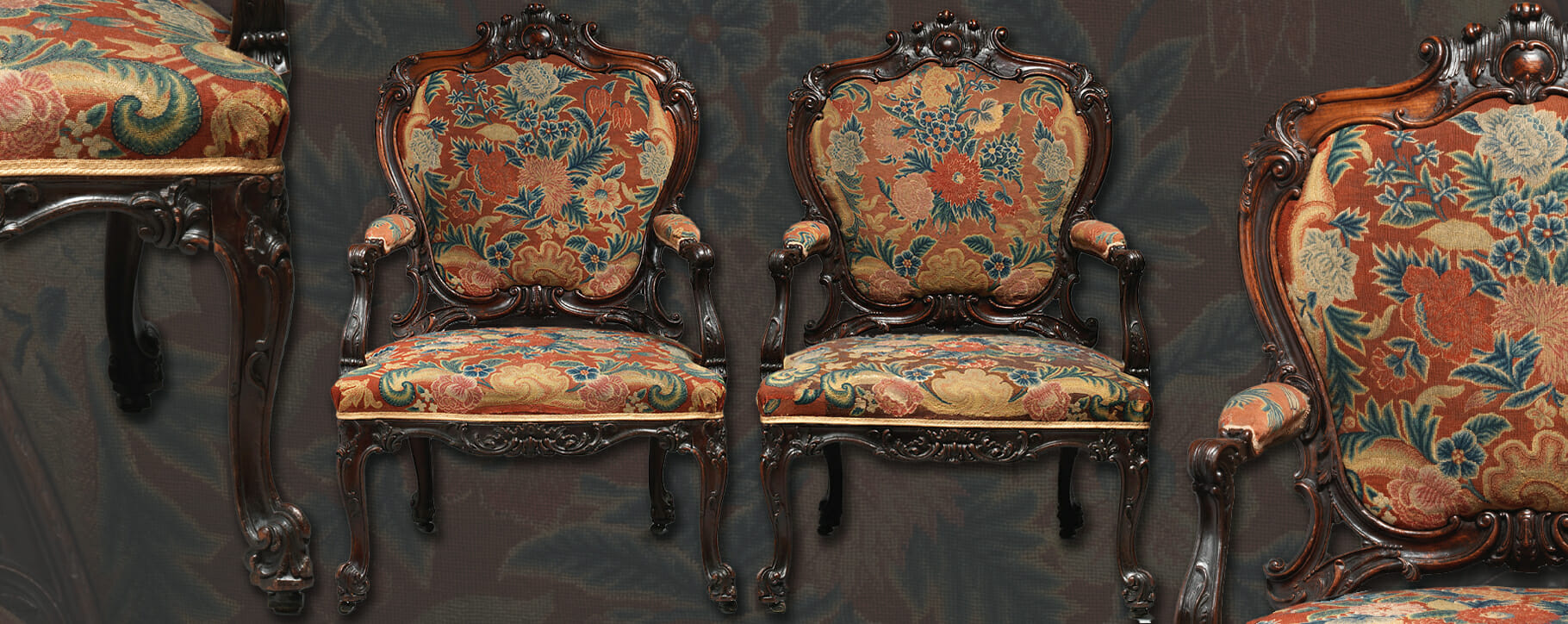 Above: two armchairs made after the ‘French chair’ style in the third edition of The Gentleman and Cabinet-Maker’s Director, dated 1765
Above: two armchairs made after the ‘French chair’ style in the third edition of The Gentleman and Cabinet-Maker’s Director, dated 1765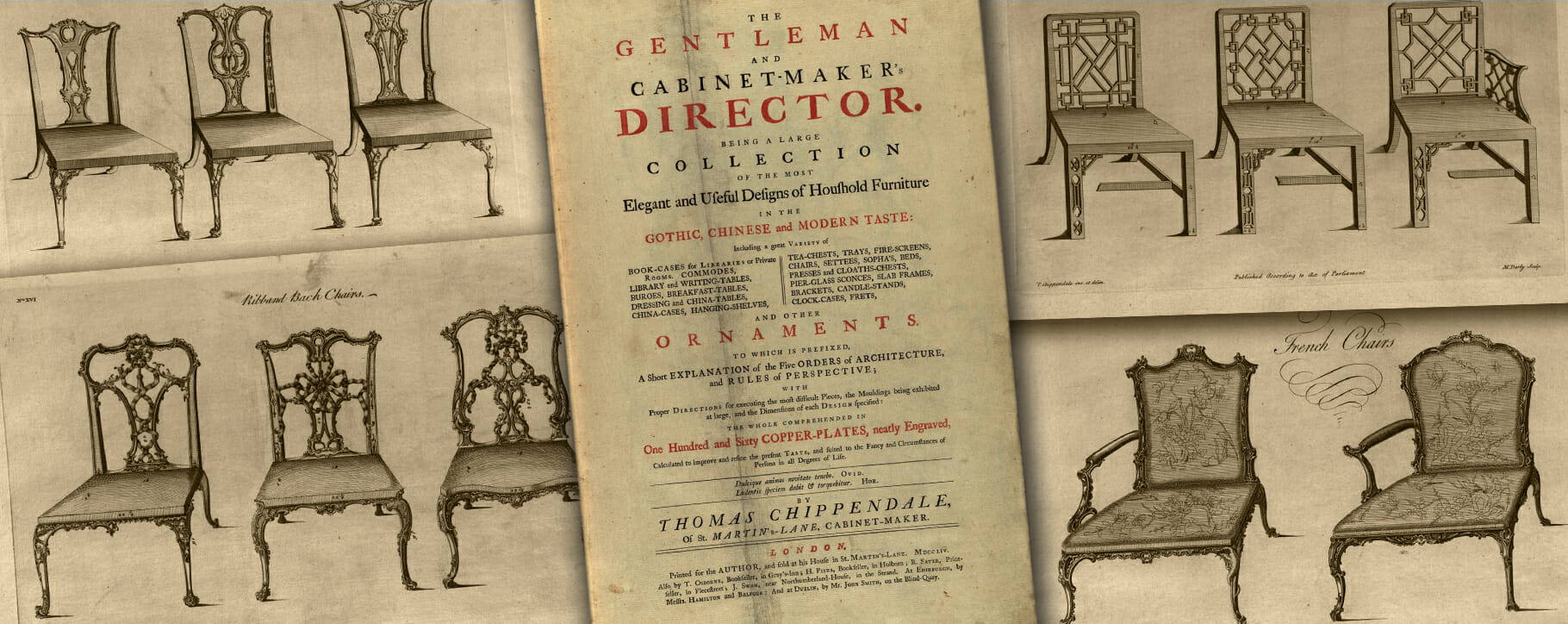 Above: the cover page and plates from The Gentleman and Cabinet Maker’s Director by Thomas Chippendale
Above: the cover page and plates from The Gentleman and Cabinet Maker’s Director by Thomas Chippendale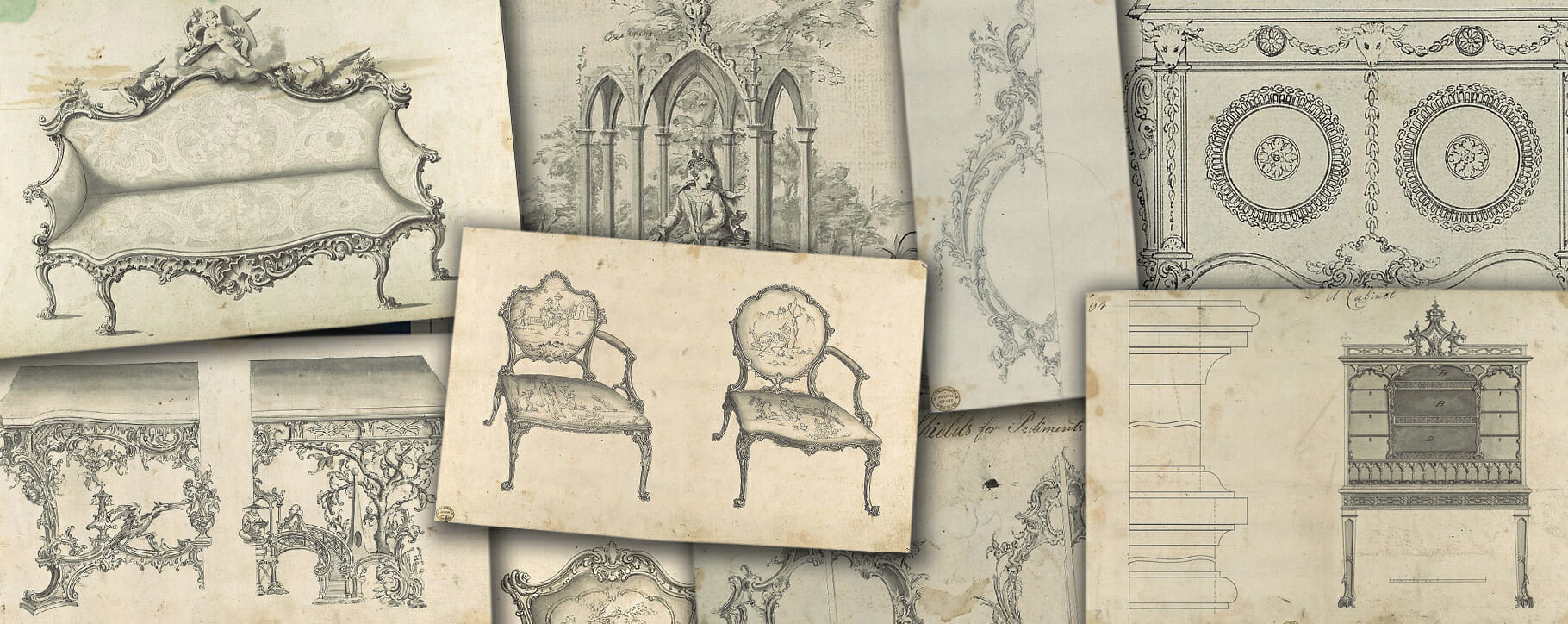 Above: a montage of designs found in Thomas Chippendale’s Cabinet Makers Directory
Above: a montage of designs found in Thomas Chippendale’s Cabinet Makers Directory Above: drawings for Chippendale’s Gentleman and Cabinet Maker’s Director published in the third edition of 1762
Above: drawings for Chippendale’s Gentleman and Cabinet Maker’s Director published in the third edition of 1762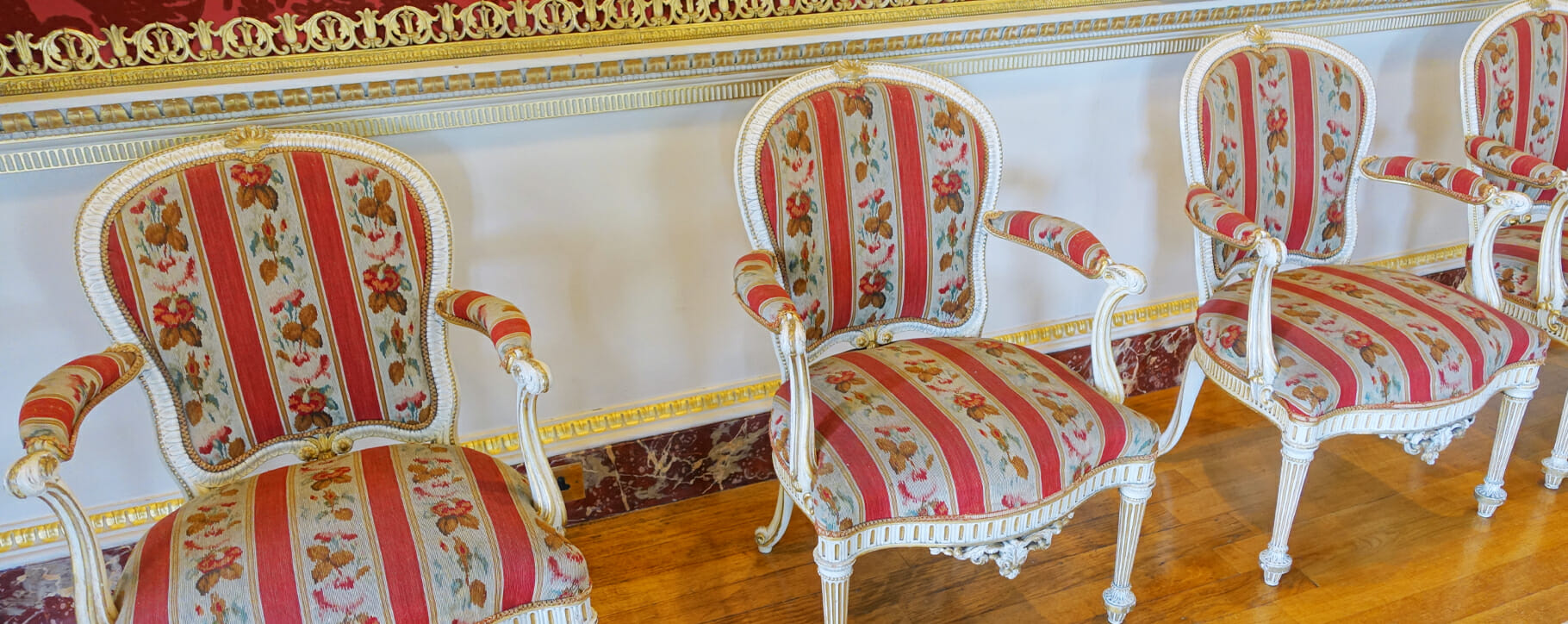 Above: a line of Chippendale chairs at Harewood House in West Yorkshire
Above: a line of Chippendale chairs at Harewood House in West Yorkshire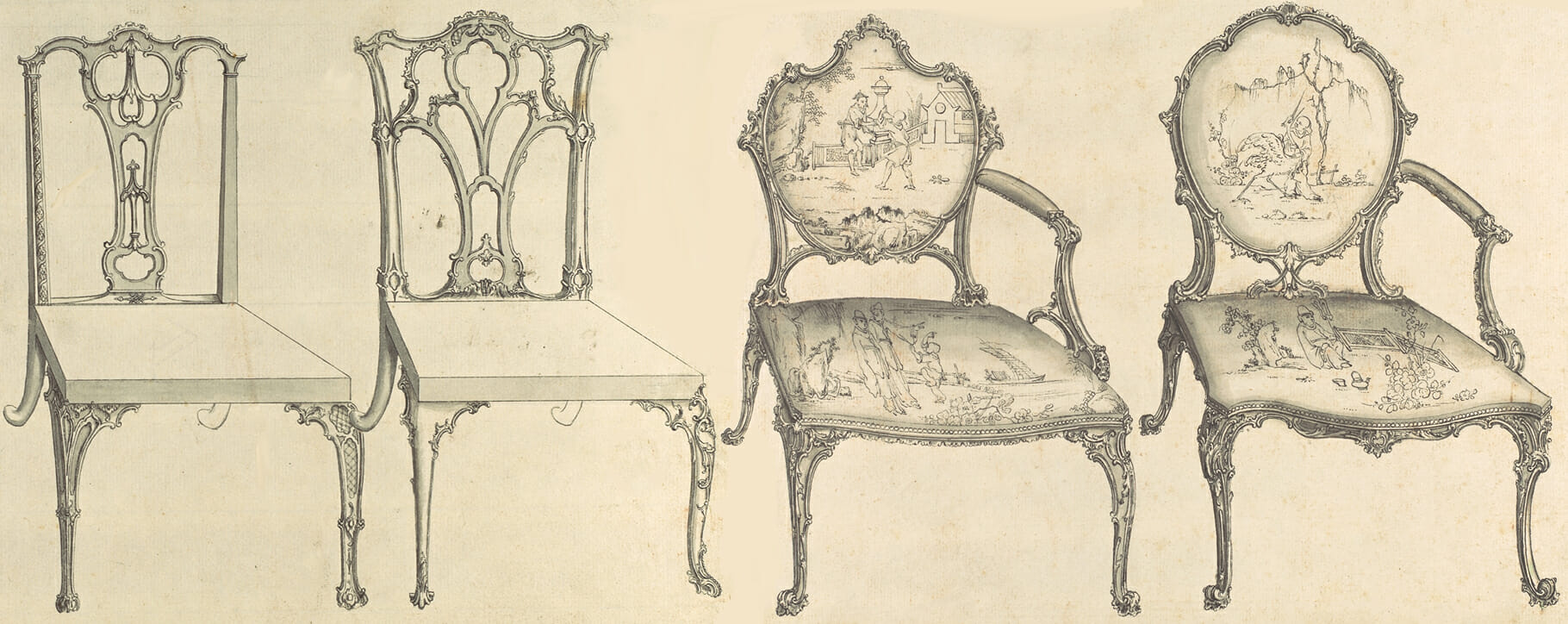 Above: a selection of Chippendale designs from the mid 18th century including rococo dining chairs (right) and Chinioserie armchairs (left)
Above: a selection of Chippendale designs from the mid 18th century including rococo dining chairs (right) and Chinioserie armchairs (left)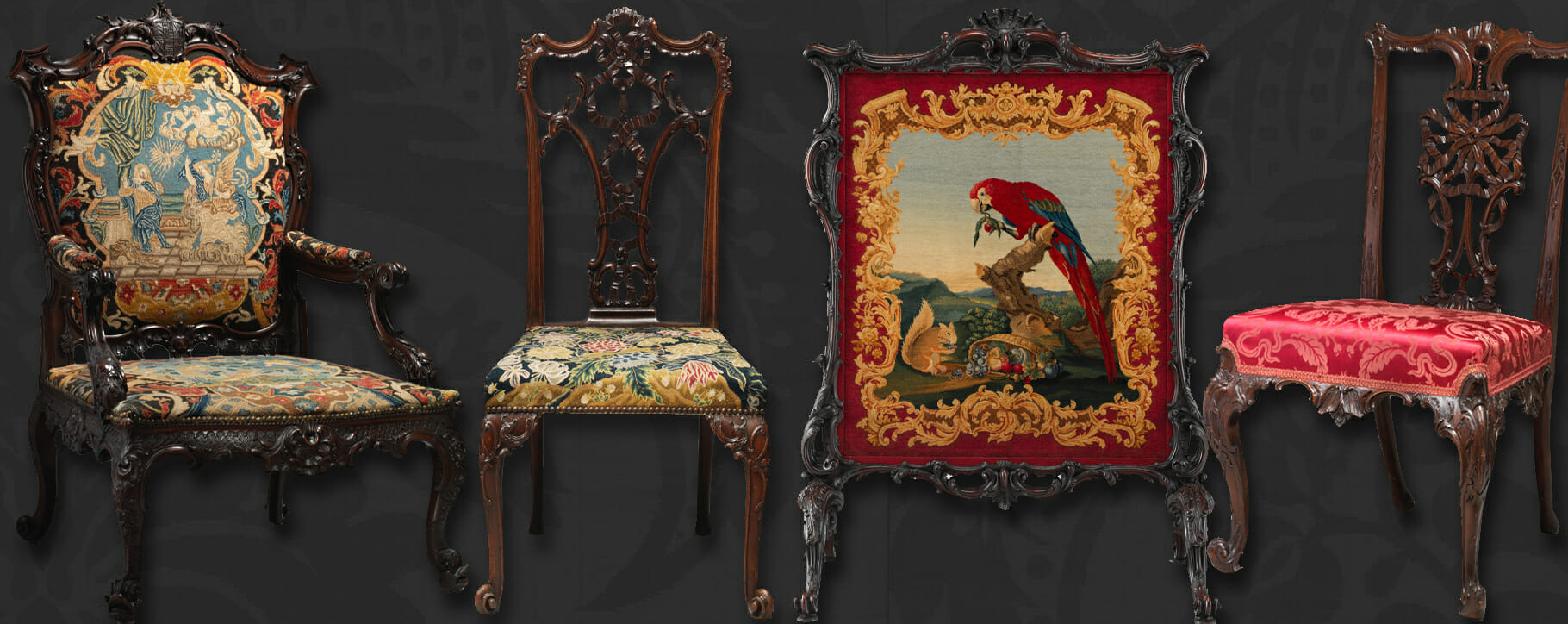 Above: a selection of Chippendale chairs, including an armchair and a fire screen with tapestry upholstery
Above: a selection of Chippendale chairs, including an armchair and a fire screen with tapestry upholstery Above: a ribband-back chair from the first edition of Chippendale’s Gentleman and Cabinet-Maker’s Director, 1754
Above: a ribband-back chair from the first edition of Chippendale’s Gentleman and Cabinet-Maker’s Director, 1754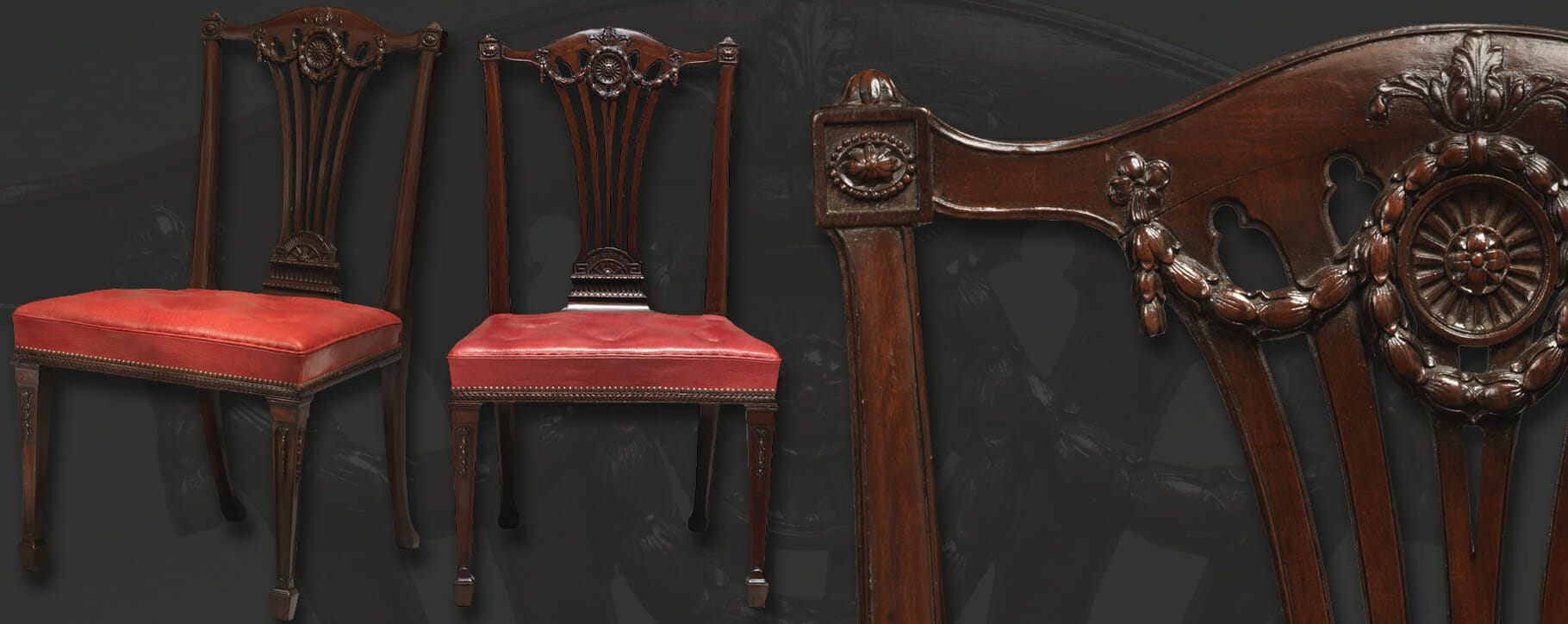 Above: a Chippendale mahogany dining chair with neoclassical features dated to 1772
Above: a Chippendale mahogany dining chair with neoclassical features dated to 1772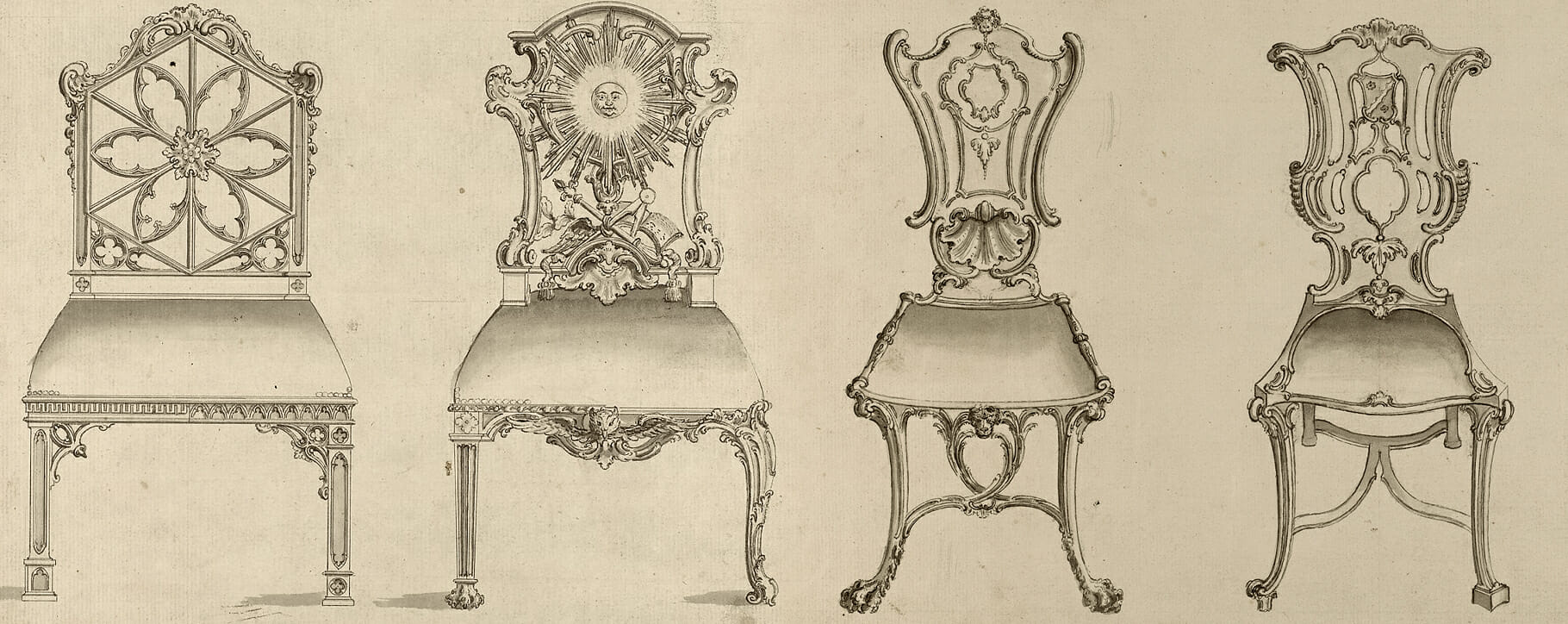 Above: a selection of Gothic and Louis XV style chair designs from the Chippendale cabinet maker’s catalogue
Above: a selection of Gothic and Louis XV style chair designs from the Chippendale cabinet maker’s catalogue 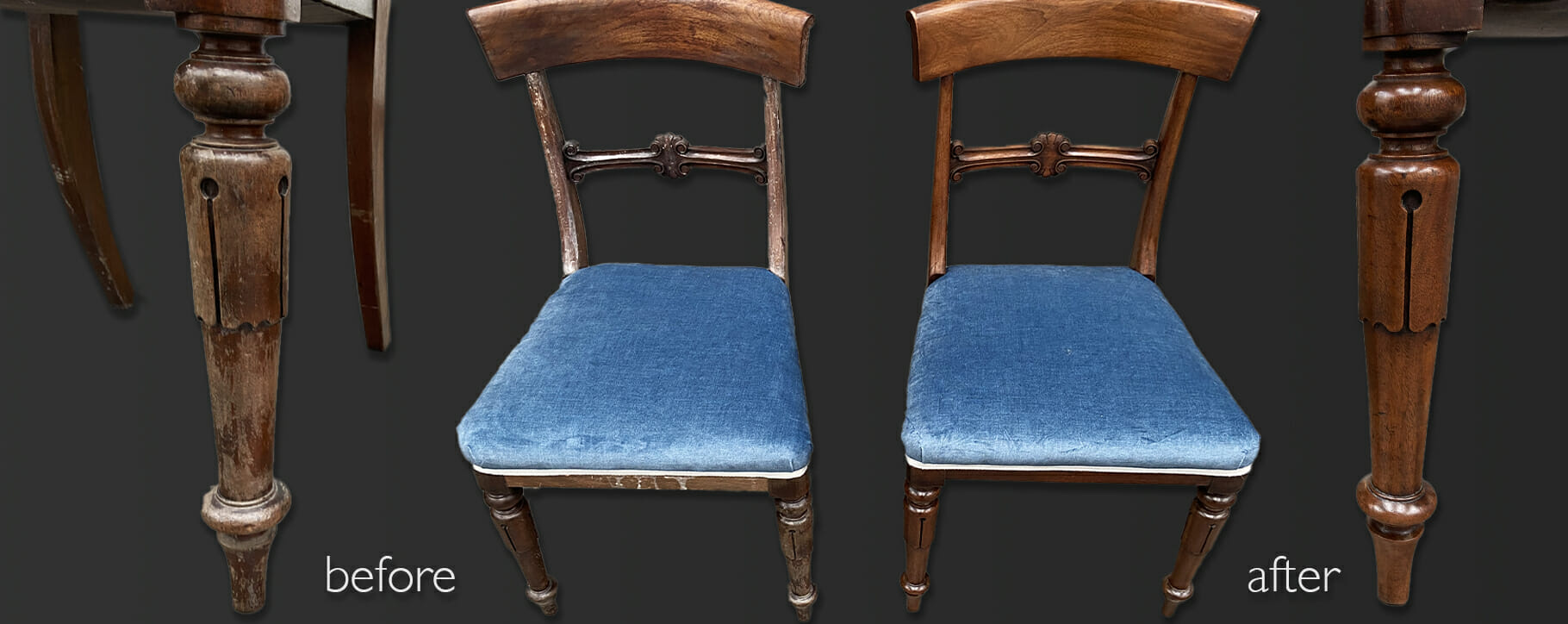 Above: an antique chair which was restored in our furniture studio following flood damage
Above: an antique chair which was restored in our furniture studio following flood damage 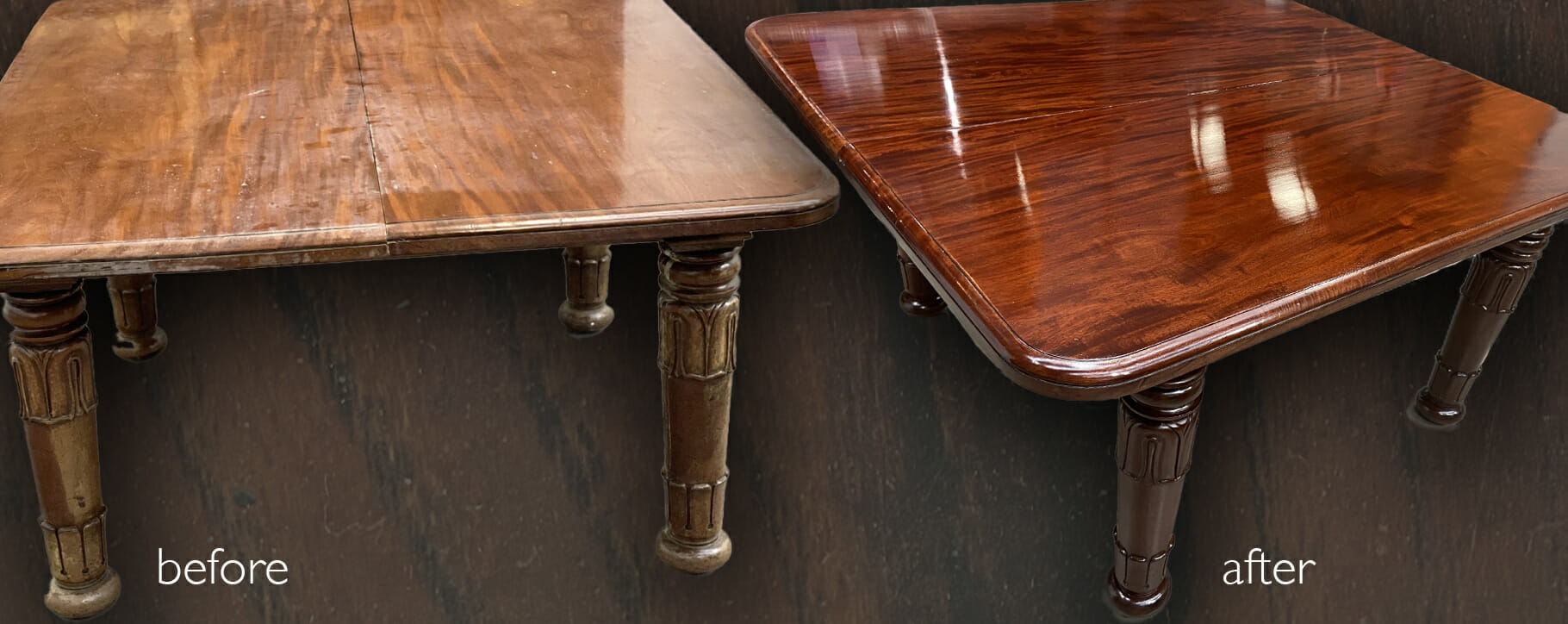 Above: a mahogany extender table before and after restoration by our team including a french polish finish
Above: a mahogany extender table before and after restoration by our team including a french polish finish




